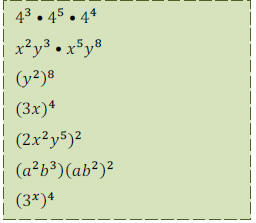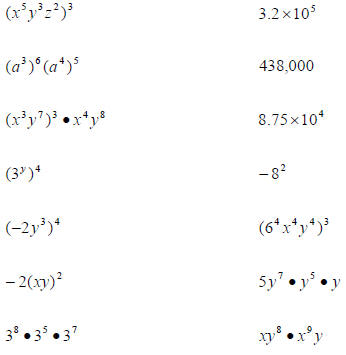- Home
- INTERMEDIATE ALGEBRA
- Course Syllabus for Algebra I
- Mid-Plains Community College
- FRACTION OF A WHOLE NUMBER
- Systems of Linear Equations
- MATH FIELD DAY
- Course Outline for Finite Mathematics
- Calculus
- Algebra Final Examination
- Math 310 Exam #2
- Review of Trigonometric Functions
- Math 118 Practice test
- Precalculus Review
- Section 12
- Literal Equations
- Calculus Term Definitions
- Math 327A Exercise 2
- Public Key Algorithms II
- Maximizing Triangle Area
- Precalculus I Review for Midterm
- REVIEW OF A FIRST COURSE IN LINEAR ALGEBRA
- Math 6310 Homework 5
- Some Proofs of the Existence of Irrational Numbers
- ALGEBRAIC PROPERTIES OF MATRIX OPERATIONS
- Math 142 - Chapter 2 Lecture Notes
- Math 112 syllabus
- Math 371 Problem Set
- Complex Numbers,Complex Functions and Contour Integrals
- APPLICATIONS OF LINEAR EQUATIONS
- Week 4 Math
- Fractions
- Investigating Liner Equations Using Graphing Calculator
- MATH 23 FINAL EXAM REVIEW
- Algebra 1
- PYTHAGOREAN THEOREM AND DISTANCE FORMULA
- Georgia Performance Standards Framework for Mathematics - Grade 6
- Intermediate Algebra
- Introduction to Fractions
- FACTORINGS OF QUADRATIC FUNCTIONS
- Elementary Algebra Syllabus
- Description of Mathematics
- Integration Review Solutions
- College Algebra - Applications
- A Tip Sheet on GREATEST COMMON FACTOR
- Syllabus for Elementary Algebra
- College Algebra II and Analytic Geometry
- Functions
- BASIC MATHEMATICS
- Quadratic Equations
- Language Arts, Math, Science, Social Studies, Char
- Fractions and Decimals
- ON SOLUTIONS OF LINEAR EQUATIONS
- Math 35 Practice Final
- Solving Equations
- Introduction to Symbolic Computation
- Course Syllabus for Math 935
- Fractions
- Fabulous Fractions
- Archimedean Property and Distribution of Q in R
- Algebra for Calculus
- Math112 Practice Test #2
- College Algebra and Trigonometry
- ALGEBRA 1A TASKS
- Description of Mathematics
- Simplifying Expressions
- Imaginary and Complex Numbers
- Building and Teaching a Math Enhancement
- Math Problems
- Algebra of Matrices Systems of Linear Equations
- Survey of Algebra
- Approximation of irrational numbers
- More about Quadratic Functions
- Long Division
- Algebraic Properties of Matrix Operation
- MATH 101 Intermediate Algebra
- Rational Number Project
- Departmental Syllabus for Finite Mathematics
- WRITTEN HOMEWORK ASSIGNMENT
- Description of Mathematics
- Rationalize Denominators
- Math Proficiency Placement Exam
- linear Equations
- Description of Mathematics & Statistics
- Systems of Linear Equations
- Algebraic Thinking
- Study Sheets - Decimals
- An Overview of Babylonian Mathematics
- Mathematics 115 - College Algebra
- Complex Numbers,Complex Functions and Contour Integrals
- Growing Circles
- Algebra II Course Curriculum
- The Natural Logarithmic Function: Integration
- Rational Expressions
- QUANTITATIVE METHODS
- Basic Facts about Rational Funct
- Statistics
- MAT 1033 FINAL WORKSHOP REVIEW
- Measurements Significant figures
- Pre-Calculus 1
- Compositions and Inverses of Functions
Section 12.1: Exponents
Review Terms, monomials, degree
Core Concepts:
Review: exponents, bases, and negative and positive numbers raised to a
power; also review the
terms squared and cubed.
Core Concepts:
→Product Rule: Multiplying two expressions with same base: Add exponents and use
the
•common base
•
•EX:

This is the same answer we would get if we |
•So if we have two variables:

•What if we have  ?
?
• Remember 2x is the same as2 times x or 2(x) .
• So, we can multiply the last two terms together using property 1 like so:

• Don’t try to include the number “2” in adding the
exponents because it is not the same
base as the variable “x” and is not included in the exponent “3” (as it would be
if it
were in parenthesis, i.e.(2x)3 - I’ll show you this in a minute.
→Power Rule: A power raised to another power is the base raised to the
product of the
powers
•
•EX:

•So
→Power of Product Rule: The power of a product is the product of a power
•
•EX:
•So
•And we can put several rules together:
→NOTE: The above properties only work when we are
dealing with multiplication of the
bases – they DO NOT work with addition of the bases
•EX:![]() because
exponents are a form of multiplication. The only operation
because
exponents are a form of multiplication. The only operation
we have is multiplication, so we are just using the commutative property to do
the
multiplication in a different order.
•BUT you cannot do this with addition: (a + b)r because this
is a mix of addition and
multiplication and groups. We must do the group FIRST!
•Try this with (2 + 3)2
by first following the order of operations, then trying to use the
property above. You’ll see that the second answer is incorrect, because we broke
the
LAW – order of operations.
•Class work determine which property to use, then simplify:

→Scientific Notation
•Definition: a number written as the product of a number between 1 and 10 and an
integer
power of 10. A number written in scientific notation has the form:
•
n ×10r , where 1 ≤ n ≤ 10 and r = an integer
•EX: write 454,000 in scientific notation. 4.54 ×105
•Ex: what number is 3.28 ×104 ? 32,800
→Mixed Classwork: (or hand out worksheet?)
Break into groups and complete the following:




